Critical Analysis of “Too Much Medicine”: Insights and Explanations from Economic Theory and Research
VerifiedAdded on 2022/11/23
|11
|2410
|421
AI Summary
This critical analysis discusses the negative impacts of “too much medicine” on healthcare systems and behaviours that affect health. It also elaborates on the implications for healthcare management and leadership.
Contribute Materials
Your contribution can guide someone’s learning journey. Share your
documents today.
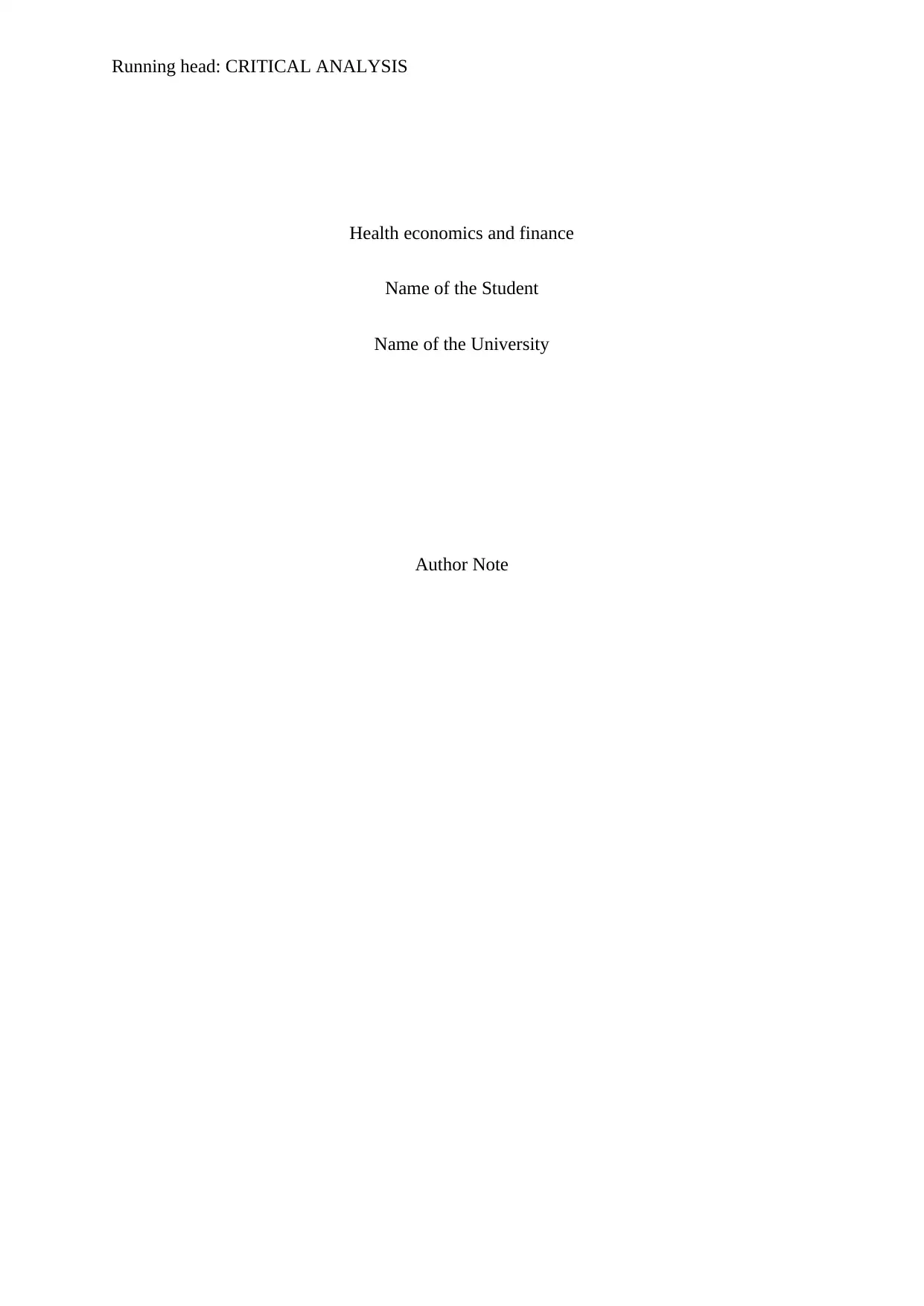
Running head: CRITICAL ANALYSIS
Health economics and finance
Name of the Student
Name of the University
Author Note
Health economics and finance
Name of the Student
Name of the University
Author Note
Secure Best Marks with AI Grader
Need help grading? Try our AI Grader for instant feedback on your assignments.
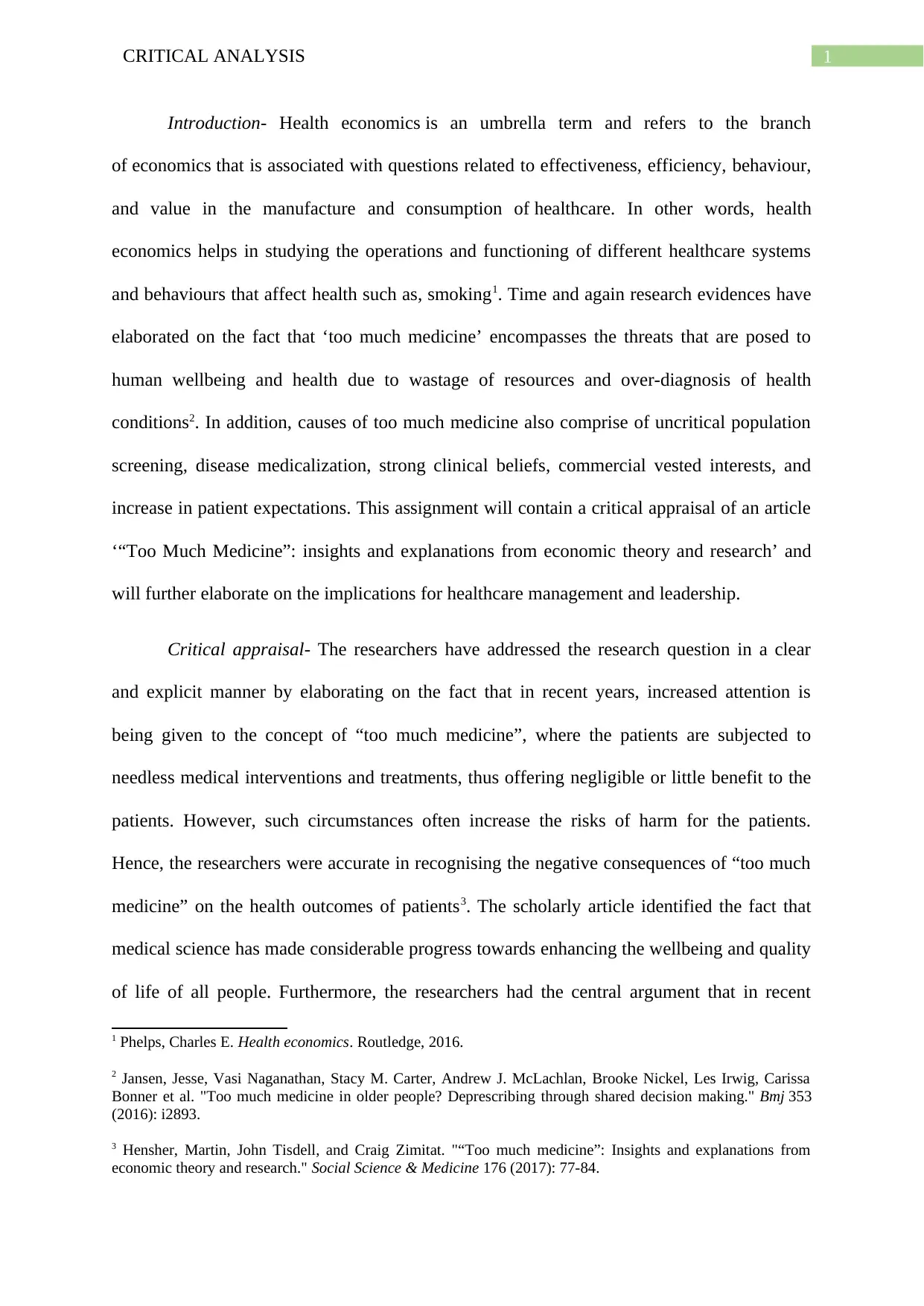
1CRITICAL ANALYSIS
Introduction- Health economics is an umbrella term and refers to the branch
of economics that is associated with questions related to effectiveness, efficiency, behaviour,
and value in the manufacture and consumption of healthcare. In other words, health
economics helps in studying the operations and functioning of different healthcare systems
and behaviours that affect health such as, smoking1. Time and again research evidences have
elaborated on the fact that ‘too much medicine’ encompasses the threats that are posed to
human wellbeing and health due to wastage of resources and over-diagnosis of health
conditions2. In addition, causes of too much medicine also comprise of uncritical population
screening, disease medicalization, strong clinical beliefs, commercial vested interests, and
increase in patient expectations. This assignment will contain a critical appraisal of an article
‘“Too Much Medicine”: insights and explanations from economic theory and research’ and
will further elaborate on the implications for healthcare management and leadership.
Critical appraisal- The researchers have addressed the research question in a clear
and explicit manner by elaborating on the fact that in recent years, increased attention is
being given to the concept of “too much medicine”, where the patients are subjected to
needless medical interventions and treatments, thus offering negligible or little benefit to the
patients. However, such circumstances often increase the risks of harm for the patients.
Hence, the researchers were accurate in recognising the negative consequences of “too much
medicine” on the health outcomes of patients3. The scholarly article identified the fact that
medical science has made considerable progress towards enhancing the wellbeing and quality
of life of all people. Furthermore, the researchers had the central argument that in recent
1 Phelps, Charles E. Health economics. Routledge, 2016.
2 Jansen, Jesse, Vasi Naganathan, Stacy M. Carter, Andrew J. McLachlan, Brooke Nickel, Les Irwig, Carissa
Bonner et al. "Too much medicine in older people? Deprescribing through shared decision making." Bmj 353
(2016): i2893.
3 Hensher, Martin, John Tisdell, and Craig Zimitat. "“Too much medicine”: Insights and explanations from
economic theory and research." Social Science & Medicine 176 (2017): 77-84.
Introduction- Health economics is an umbrella term and refers to the branch
of economics that is associated with questions related to effectiveness, efficiency, behaviour,
and value in the manufacture and consumption of healthcare. In other words, health
economics helps in studying the operations and functioning of different healthcare systems
and behaviours that affect health such as, smoking1. Time and again research evidences have
elaborated on the fact that ‘too much medicine’ encompasses the threats that are posed to
human wellbeing and health due to wastage of resources and over-diagnosis of health
conditions2. In addition, causes of too much medicine also comprise of uncritical population
screening, disease medicalization, strong clinical beliefs, commercial vested interests, and
increase in patient expectations. This assignment will contain a critical appraisal of an article
‘“Too Much Medicine”: insights and explanations from economic theory and research’ and
will further elaborate on the implications for healthcare management and leadership.
Critical appraisal- The researchers have addressed the research question in a clear
and explicit manner by elaborating on the fact that in recent years, increased attention is
being given to the concept of “too much medicine”, where the patients are subjected to
needless medical interventions and treatments, thus offering negligible or little benefit to the
patients. However, such circumstances often increase the risks of harm for the patients.
Hence, the researchers were accurate in recognising the negative consequences of “too much
medicine” on the health outcomes of patients3. The scholarly article identified the fact that
medical science has made considerable progress towards enhancing the wellbeing and quality
of life of all people. Furthermore, the researchers had the central argument that in recent
1 Phelps, Charles E. Health economics. Routledge, 2016.
2 Jansen, Jesse, Vasi Naganathan, Stacy M. Carter, Andrew J. McLachlan, Brooke Nickel, Les Irwig, Carissa
Bonner et al. "Too much medicine in older people? Deprescribing through shared decision making." Bmj 353
(2016): i2893.
3 Hensher, Martin, John Tisdell, and Craig Zimitat. "“Too much medicine”: Insights and explanations from
economic theory and research." Social Science & Medicine 176 (2017): 77-84.
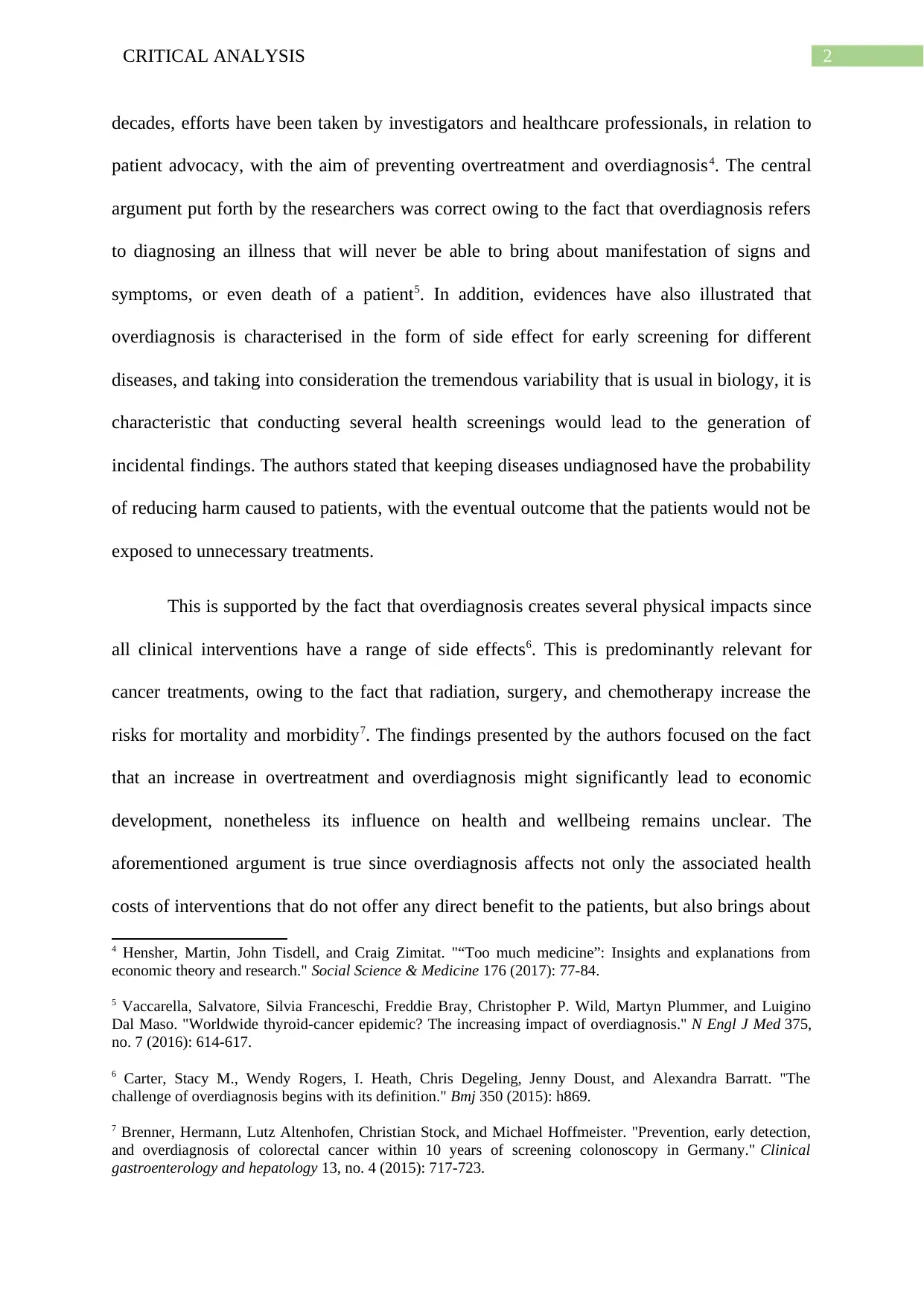
2CRITICAL ANALYSIS
decades, efforts have been taken by investigators and healthcare professionals, in relation to
patient advocacy, with the aim of preventing overtreatment and overdiagnosis4. The central
argument put forth by the researchers was correct owing to the fact that overdiagnosis refers
to diagnosing an illness that will never be able to bring about manifestation of signs and
symptoms, or even death of a patient5. In addition, evidences have also illustrated that
overdiagnosis is characterised in the form of side effect for early screening for different
diseases, and taking into consideration the tremendous variability that is usual in biology, it is
characteristic that conducting several health screenings would lead to the generation of
incidental findings. The authors stated that keeping diseases undiagnosed have the probability
of reducing harm caused to patients, with the eventual outcome that the patients would not be
exposed to unnecessary treatments.
This is supported by the fact that overdiagnosis creates several physical impacts since
all clinical interventions have a range of side effects6. This is predominantly relevant for
cancer treatments, owing to the fact that radiation, surgery, and chemotherapy increase the
risks for mortality and morbidity7. The findings presented by the authors focused on the fact
that an increase in overtreatment and overdiagnosis might significantly lead to economic
development, nonetheless its influence on health and wellbeing remains unclear. The
aforementioned argument is true since overdiagnosis affects not only the associated health
costs of interventions that do not offer any direct benefit to the patients, but also brings about
4 Hensher, Martin, John Tisdell, and Craig Zimitat. "“Too much medicine”: Insights and explanations from
economic theory and research." Social Science & Medicine 176 (2017): 77-84.
5 Vaccarella, Salvatore, Silvia Franceschi, Freddie Bray, Christopher P. Wild, Martyn Plummer, and Luigino
Dal Maso. "Worldwide thyroid-cancer epidemic? The increasing impact of overdiagnosis." N Engl J Med 375,
no. 7 (2016): 614-617.
6 Carter, Stacy M., Wendy Rogers, I. Heath, Chris Degeling, Jenny Doust, and Alexandra Barratt. "The
challenge of overdiagnosis begins with its definition." Bmj 350 (2015): h869.
7 Brenner, Hermann, Lutz Altenhofen, Christian Stock, and Michael Hoffmeister. "Prevention, early detection,
and overdiagnosis of colorectal cancer within 10 years of screening colonoscopy in Germany." Clinical
gastroenterology and hepatology 13, no. 4 (2015): 717-723.
decades, efforts have been taken by investigators and healthcare professionals, in relation to
patient advocacy, with the aim of preventing overtreatment and overdiagnosis4. The central
argument put forth by the researchers was correct owing to the fact that overdiagnosis refers
to diagnosing an illness that will never be able to bring about manifestation of signs and
symptoms, or even death of a patient5. In addition, evidences have also illustrated that
overdiagnosis is characterised in the form of side effect for early screening for different
diseases, and taking into consideration the tremendous variability that is usual in biology, it is
characteristic that conducting several health screenings would lead to the generation of
incidental findings. The authors stated that keeping diseases undiagnosed have the probability
of reducing harm caused to patients, with the eventual outcome that the patients would not be
exposed to unnecessary treatments.
This is supported by the fact that overdiagnosis creates several physical impacts since
all clinical interventions have a range of side effects6. This is predominantly relevant for
cancer treatments, owing to the fact that radiation, surgery, and chemotherapy increase the
risks for mortality and morbidity7. The findings presented by the authors focused on the fact
that an increase in overtreatment and overdiagnosis might significantly lead to economic
development, nonetheless its influence on health and wellbeing remains unclear. The
aforementioned argument is true since overdiagnosis affects not only the associated health
costs of interventions that do not offer any direct benefit to the patients, but also brings about
4 Hensher, Martin, John Tisdell, and Craig Zimitat. "“Too much medicine”: Insights and explanations from
economic theory and research." Social Science & Medicine 176 (2017): 77-84.
5 Vaccarella, Salvatore, Silvia Franceschi, Freddie Bray, Christopher P. Wild, Martyn Plummer, and Luigino
Dal Maso. "Worldwide thyroid-cancer epidemic? The increasing impact of overdiagnosis." N Engl J Med 375,
no. 7 (2016): 614-617.
6 Carter, Stacy M., Wendy Rogers, I. Heath, Chris Degeling, Jenny Doust, and Alexandra Barratt. "The
challenge of overdiagnosis begins with its definition." Bmj 350 (2015): h869.
7 Brenner, Hermann, Lutz Altenhofen, Christian Stock, and Michael Hoffmeister. "Prevention, early detection,
and overdiagnosis of colorectal cancer within 10 years of screening colonoscopy in Germany." Clinical
gastroenterology and hepatology 13, no. 4 (2015): 717-723.
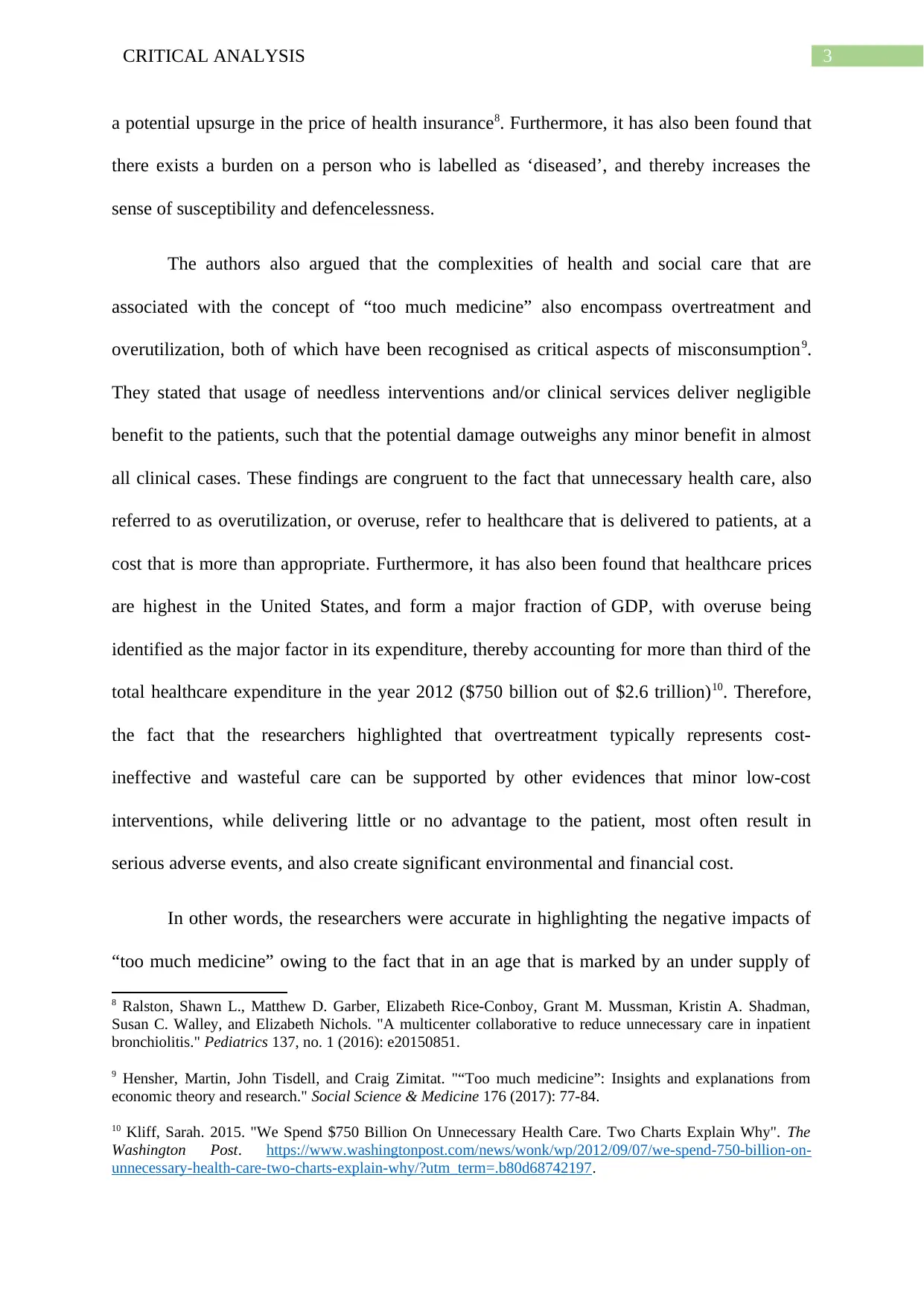
3CRITICAL ANALYSIS
a potential upsurge in the price of health insurance8. Furthermore, it has also been found that
there exists a burden on a person who is labelled as ‘diseased’, and thereby increases the
sense of susceptibility and defencelessness.
The authors also argued that the complexities of health and social care that are
associated with the concept of “too much medicine” also encompass overtreatment and
overutilization, both of which have been recognised as critical aspects of misconsumption9.
They stated that usage of needless interventions and/or clinical services deliver negligible
benefit to the patients, such that the potential damage outweighs any minor benefit in almost
all clinical cases. These findings are congruent to the fact that unnecessary health care, also
referred to as overutilization, or overuse, refer to healthcare that is delivered to patients, at a
cost that is more than appropriate. Furthermore, it has also been found that healthcare prices
are highest in the United States, and form a major fraction of GDP, with overuse being
identified as the major factor in its expenditure, thereby accounting for more than third of the
total healthcare expenditure in the year 2012 ($750 billion out of $2.6 trillion)10. Therefore,
the fact that the researchers highlighted that overtreatment typically represents cost-
ineffective and wasteful care can be supported by other evidences that minor low-cost
interventions, while delivering little or no advantage to the patient, most often result in
serious adverse events, and also create significant environmental and financial cost.
In other words, the researchers were accurate in highlighting the negative impacts of
“too much medicine” owing to the fact that in an age that is marked by an under supply of
8 Ralston, Shawn L., Matthew D. Garber, Elizabeth Rice-Conboy, Grant M. Mussman, Kristin A. Shadman,
Susan C. Walley, and Elizabeth Nichols. "A multicenter collaborative to reduce unnecessary care in inpatient
bronchiolitis." Pediatrics 137, no. 1 (2016): e20150851.
9 Hensher, Martin, John Tisdell, and Craig Zimitat. "“Too much medicine”: Insights and explanations from
economic theory and research." Social Science & Medicine 176 (2017): 77-84.
10 Kliff, Sarah. 2015. "We Spend $750 Billion On Unnecessary Health Care. Two Charts Explain Why". The
Washington Post. https://www.washingtonpost.com/news/wonk/wp/2012/09/07/we-spend-750-billion-on-
unnecessary-health-care-two-charts-explain-why/?utm_term=.b80d68742197.
a potential upsurge in the price of health insurance8. Furthermore, it has also been found that
there exists a burden on a person who is labelled as ‘diseased’, and thereby increases the
sense of susceptibility and defencelessness.
The authors also argued that the complexities of health and social care that are
associated with the concept of “too much medicine” also encompass overtreatment and
overutilization, both of which have been recognised as critical aspects of misconsumption9.
They stated that usage of needless interventions and/or clinical services deliver negligible
benefit to the patients, such that the potential damage outweighs any minor benefit in almost
all clinical cases. These findings are congruent to the fact that unnecessary health care, also
referred to as overutilization, or overuse, refer to healthcare that is delivered to patients, at a
cost that is more than appropriate. Furthermore, it has also been found that healthcare prices
are highest in the United States, and form a major fraction of GDP, with overuse being
identified as the major factor in its expenditure, thereby accounting for more than third of the
total healthcare expenditure in the year 2012 ($750 billion out of $2.6 trillion)10. Therefore,
the fact that the researchers highlighted that overtreatment typically represents cost-
ineffective and wasteful care can be supported by other evidences that minor low-cost
interventions, while delivering little or no advantage to the patient, most often result in
serious adverse events, and also create significant environmental and financial cost.
In other words, the researchers were accurate in highlighting the negative impacts of
“too much medicine” owing to the fact that in an age that is marked by an under supply of
8 Ralston, Shawn L., Matthew D. Garber, Elizabeth Rice-Conboy, Grant M. Mussman, Kristin A. Shadman,
Susan C. Walley, and Elizabeth Nichols. "A multicenter collaborative to reduce unnecessary care in inpatient
bronchiolitis." Pediatrics 137, no. 1 (2016): e20150851.
9 Hensher, Martin, John Tisdell, and Craig Zimitat. "“Too much medicine”: Insights and explanations from
economic theory and research." Social Science & Medicine 176 (2017): 77-84.
10 Kliff, Sarah. 2015. "We Spend $750 Billion On Unnecessary Health Care. Two Charts Explain Why". The
Washington Post. https://www.washingtonpost.com/news/wonk/wp/2012/09/07/we-spend-750-billion-on-
unnecessary-health-care-two-charts-explain-why/?utm_term=.b80d68742197.
Secure Best Marks with AI Grader
Need help grading? Try our AI Grader for instant feedback on your assignments.
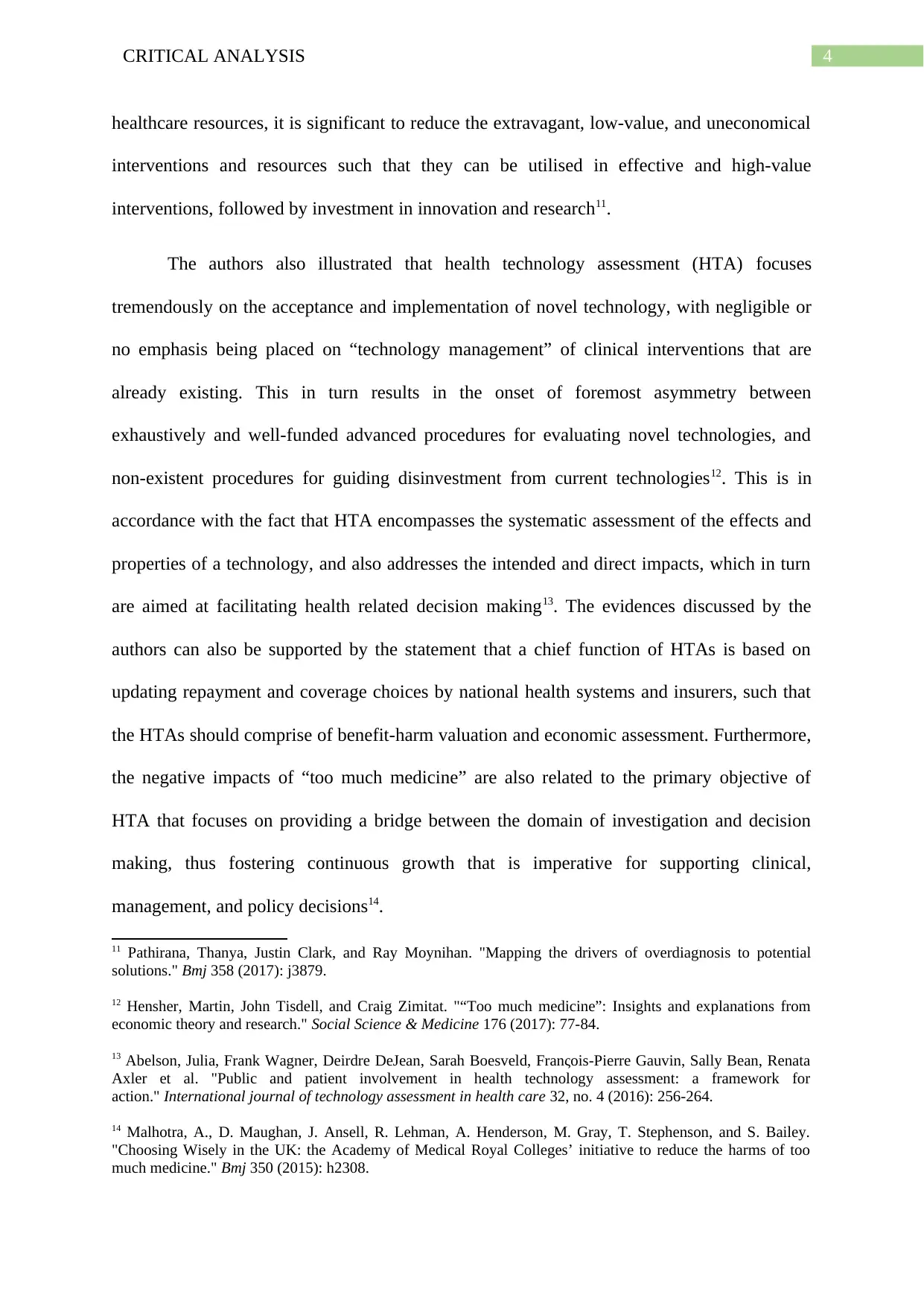
4CRITICAL ANALYSIS
healthcare resources, it is significant to reduce the extravagant, low-value, and uneconomical
interventions and resources such that they can be utilised in effective and high-value
interventions, followed by investment in innovation and research11.
The authors also illustrated that health technology assessment (HTA) focuses
tremendously on the acceptance and implementation of novel technology, with negligible or
no emphasis being placed on “technology management” of clinical interventions that are
already existing. This in turn results in the onset of foremost asymmetry between
exhaustively and well-funded advanced procedures for evaluating novel technologies, and
non-existent procedures for guiding disinvestment from current technologies12. This is in
accordance with the fact that HTA encompasses the systematic assessment of the effects and
properties of a technology, and also addresses the intended and direct impacts, which in turn
are aimed at facilitating health related decision making13. The evidences discussed by the
authors can also be supported by the statement that a chief function of HTAs is based on
updating repayment and coverage choices by national health systems and insurers, such that
the HTAs should comprise of benefit-harm valuation and economic assessment. Furthermore,
the negative impacts of “too much medicine” are also related to the primary objective of
HTA that focuses on providing a bridge between the domain of investigation and decision
making, thus fostering continuous growth that is imperative for supporting clinical,
management, and policy decisions14.
11 Pathirana, Thanya, Justin Clark, and Ray Moynihan. "Mapping the drivers of overdiagnosis to potential
solutions." Bmj 358 (2017): j3879.
12 Hensher, Martin, John Tisdell, and Craig Zimitat. "“Too much medicine”: Insights and explanations from
economic theory and research." Social Science & Medicine 176 (2017): 77-84.
13 Abelson, Julia, Frank Wagner, Deirdre DeJean, Sarah Boesveld, Franςois-Pierre Gauvin, Sally Bean, Renata
Axler et al. "Public and patient involvement in health technology assessment: a framework for
action." International journal of technology assessment in health care 32, no. 4 (2016): 256-264.
14 Malhotra, A., D. Maughan, J. Ansell, R. Lehman, A. Henderson, M. Gray, T. Stephenson, and S. Bailey.
"Choosing Wisely in the UK: the Academy of Medical Royal Colleges’ initiative to reduce the harms of too
much medicine." Bmj 350 (2015): h2308.
healthcare resources, it is significant to reduce the extravagant, low-value, and uneconomical
interventions and resources such that they can be utilised in effective and high-value
interventions, followed by investment in innovation and research11.
The authors also illustrated that health technology assessment (HTA) focuses
tremendously on the acceptance and implementation of novel technology, with negligible or
no emphasis being placed on “technology management” of clinical interventions that are
already existing. This in turn results in the onset of foremost asymmetry between
exhaustively and well-funded advanced procedures for evaluating novel technologies, and
non-existent procedures for guiding disinvestment from current technologies12. This is in
accordance with the fact that HTA encompasses the systematic assessment of the effects and
properties of a technology, and also addresses the intended and direct impacts, which in turn
are aimed at facilitating health related decision making13. The evidences discussed by the
authors can also be supported by the statement that a chief function of HTAs is based on
updating repayment and coverage choices by national health systems and insurers, such that
the HTAs should comprise of benefit-harm valuation and economic assessment. Furthermore,
the negative impacts of “too much medicine” are also related to the primary objective of
HTA that focuses on providing a bridge between the domain of investigation and decision
making, thus fostering continuous growth that is imperative for supporting clinical,
management, and policy decisions14.
11 Pathirana, Thanya, Justin Clark, and Ray Moynihan. "Mapping the drivers of overdiagnosis to potential
solutions." Bmj 358 (2017): j3879.
12 Hensher, Martin, John Tisdell, and Craig Zimitat. "“Too much medicine”: Insights and explanations from
economic theory and research." Social Science & Medicine 176 (2017): 77-84.
13 Abelson, Julia, Frank Wagner, Deirdre DeJean, Sarah Boesveld, Franςois-Pierre Gauvin, Sally Bean, Renata
Axler et al. "Public and patient involvement in health technology assessment: a framework for
action." International journal of technology assessment in health care 32, no. 4 (2016): 256-264.
14 Malhotra, A., D. Maughan, J. Ansell, R. Lehman, A. Henderson, M. Gray, T. Stephenson, and S. Bailey.
"Choosing Wisely in the UK: the Academy of Medical Royal Colleges’ initiative to reduce the harms of too
much medicine." Bmj 350 (2015): h2308.
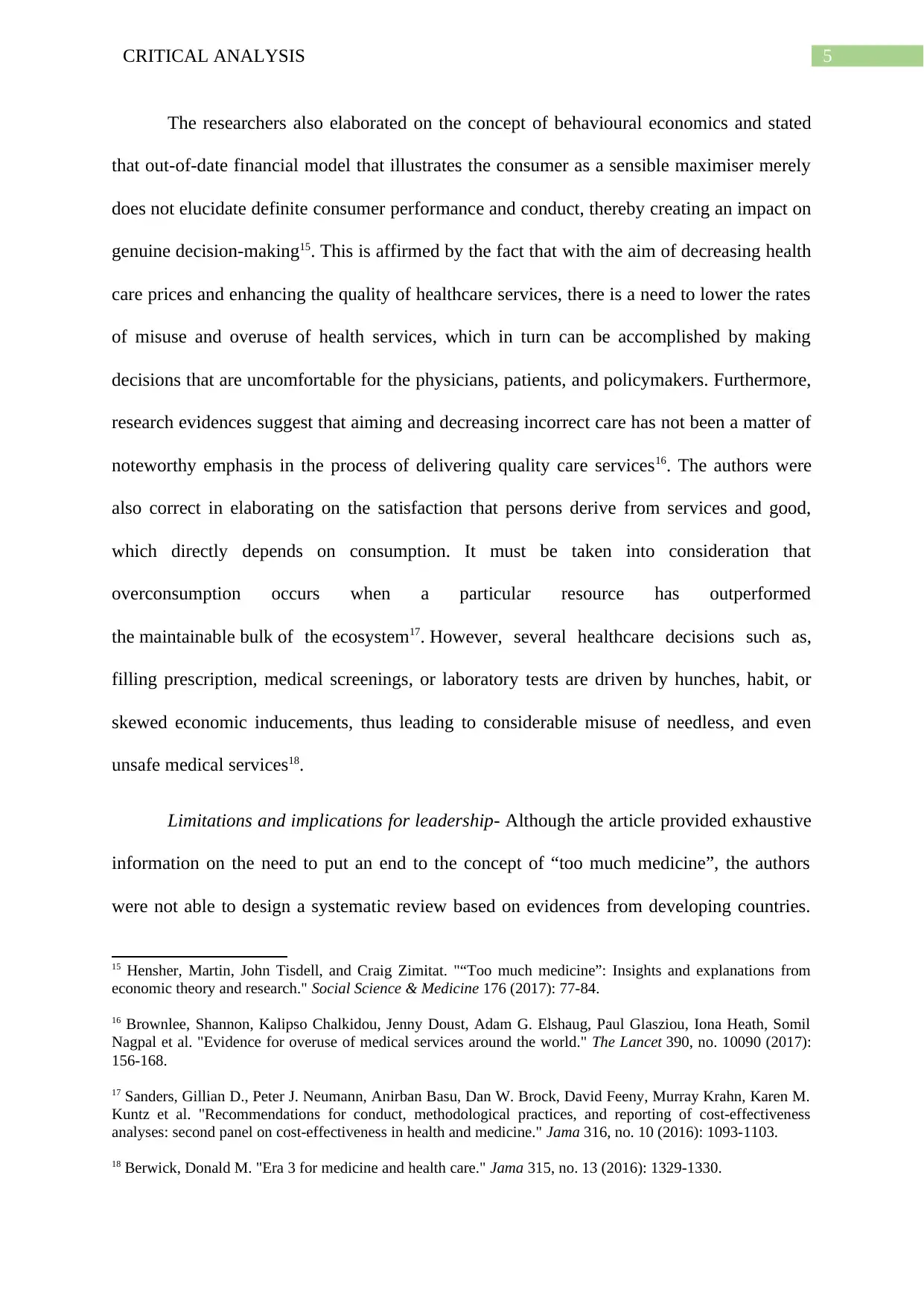
5CRITICAL ANALYSIS
The researchers also elaborated on the concept of behavioural economics and stated
that out-of-date financial model that illustrates the consumer as a sensible maximiser merely
does not elucidate definite consumer performance and conduct, thereby creating an impact on
genuine decision-making15. This is affirmed by the fact that with the aim of decreasing health
care prices and enhancing the quality of healthcare services, there is a need to lower the rates
of misuse and overuse of health services, which in turn can be accomplished by making
decisions that are uncomfortable for the physicians, patients, and policymakers. Furthermore,
research evidences suggest that aiming and decreasing incorrect care has not been a matter of
noteworthy emphasis in the process of delivering quality care services16. The authors were
also correct in elaborating on the satisfaction that persons derive from services and good,
which directly depends on consumption. It must be taken into consideration that
overconsumption occurs when a particular resource has outperformed
the maintainable bulk of the ecosystem17. However, several healthcare decisions such as,
filling prescription, medical screenings, or laboratory tests are driven by hunches, habit, or
skewed economic inducements, thus leading to considerable misuse of needless, and even
unsafe medical services18.
Limitations and implications for leadership- Although the article provided exhaustive
information on the need to put an end to the concept of “too much medicine”, the authors
were not able to design a systematic review based on evidences from developing countries.
15 Hensher, Martin, John Tisdell, and Craig Zimitat. "“Too much medicine”: Insights and explanations from
economic theory and research." Social Science & Medicine 176 (2017): 77-84.
16 Brownlee, Shannon, Kalipso Chalkidou, Jenny Doust, Adam G. Elshaug, Paul Glasziou, Iona Heath, Somil
Nagpal et al. "Evidence for overuse of medical services around the world." The Lancet 390, no. 10090 (2017):
156-168.
17 Sanders, Gillian D., Peter J. Neumann, Anirban Basu, Dan W. Brock, David Feeny, Murray Krahn, Karen M.
Kuntz et al. "Recommendations for conduct, methodological practices, and reporting of cost-effectiveness
analyses: second panel on cost-effectiveness in health and medicine." Jama 316, no. 10 (2016): 1093-1103.
18 Berwick, Donald M. "Era 3 for medicine and health care." Jama 315, no. 13 (2016): 1329-1330.
The researchers also elaborated on the concept of behavioural economics and stated
that out-of-date financial model that illustrates the consumer as a sensible maximiser merely
does not elucidate definite consumer performance and conduct, thereby creating an impact on
genuine decision-making15. This is affirmed by the fact that with the aim of decreasing health
care prices and enhancing the quality of healthcare services, there is a need to lower the rates
of misuse and overuse of health services, which in turn can be accomplished by making
decisions that are uncomfortable for the physicians, patients, and policymakers. Furthermore,
research evidences suggest that aiming and decreasing incorrect care has not been a matter of
noteworthy emphasis in the process of delivering quality care services16. The authors were
also correct in elaborating on the satisfaction that persons derive from services and good,
which directly depends on consumption. It must be taken into consideration that
overconsumption occurs when a particular resource has outperformed
the maintainable bulk of the ecosystem17. However, several healthcare decisions such as,
filling prescription, medical screenings, or laboratory tests are driven by hunches, habit, or
skewed economic inducements, thus leading to considerable misuse of needless, and even
unsafe medical services18.
Limitations and implications for leadership- Although the article provided exhaustive
information on the need to put an end to the concept of “too much medicine”, the authors
were not able to design a systematic review based on evidences from developing countries.
15 Hensher, Martin, John Tisdell, and Craig Zimitat. "“Too much medicine”: Insights and explanations from
economic theory and research." Social Science & Medicine 176 (2017): 77-84.
16 Brownlee, Shannon, Kalipso Chalkidou, Jenny Doust, Adam G. Elshaug, Paul Glasziou, Iona Heath, Somil
Nagpal et al. "Evidence for overuse of medical services around the world." The Lancet 390, no. 10090 (2017):
156-168.
17 Sanders, Gillian D., Peter J. Neumann, Anirban Basu, Dan W. Brock, David Feeny, Murray Krahn, Karen M.
Kuntz et al. "Recommendations for conduct, methodological practices, and reporting of cost-effectiveness
analyses: second panel on cost-effectiveness in health and medicine." Jama 316, no. 10 (2016): 1093-1103.
18 Berwick, Donald M. "Era 3 for medicine and health care." Jama 315, no. 13 (2016): 1329-1330.
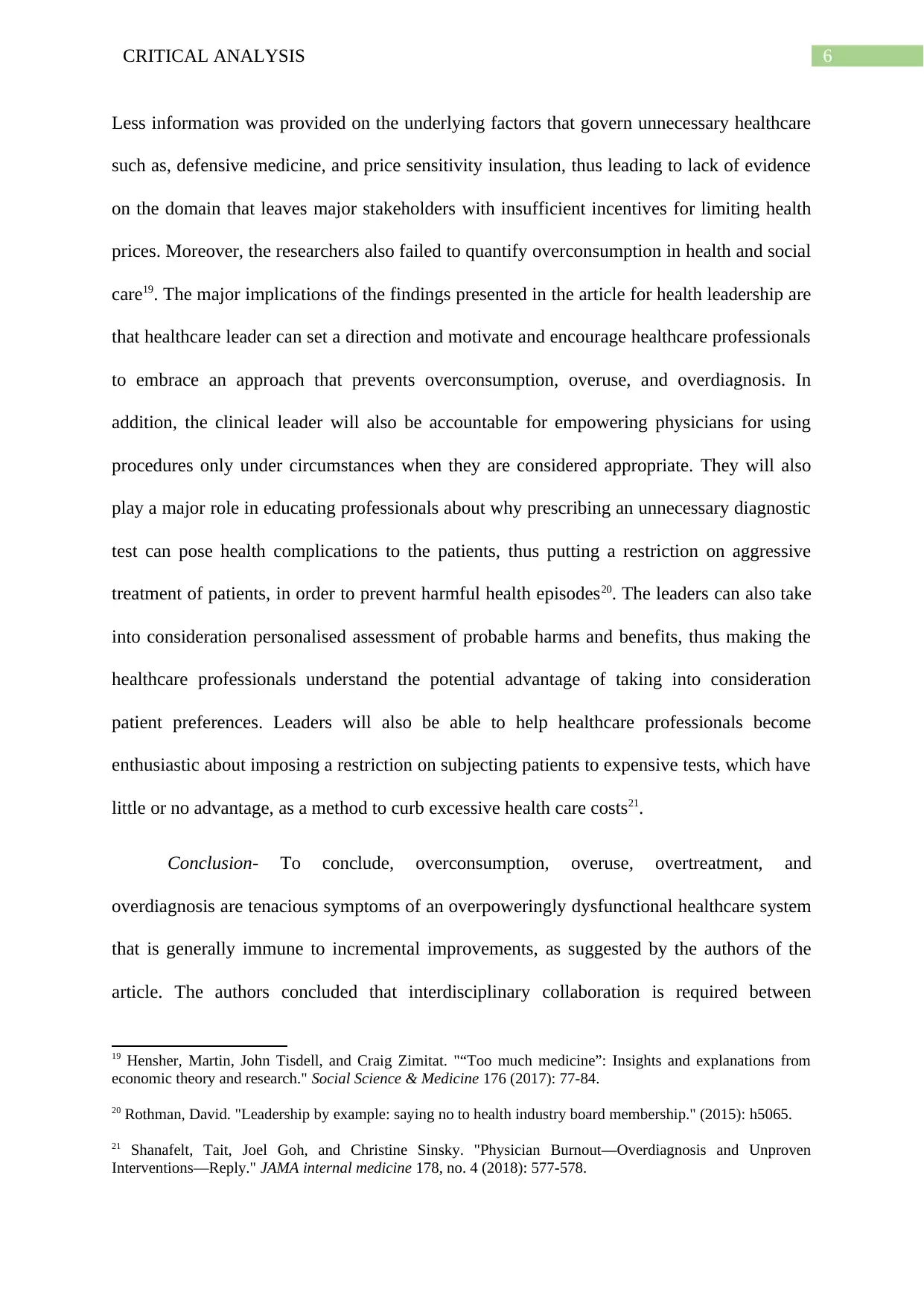
6CRITICAL ANALYSIS
Less information was provided on the underlying factors that govern unnecessary healthcare
such as, defensive medicine, and price sensitivity insulation, thus leading to lack of evidence
on the domain that leaves major stakeholders with insufficient incentives for limiting health
prices. Moreover, the researchers also failed to quantify overconsumption in health and social
care19. The major implications of the findings presented in the article for health leadership are
that healthcare leader can set a direction and motivate and encourage healthcare professionals
to embrace an approach that prevents overconsumption, overuse, and overdiagnosis. In
addition, the clinical leader will also be accountable for empowering physicians for using
procedures only under circumstances when they are considered appropriate. They will also
play a major role in educating professionals about why prescribing an unnecessary diagnostic
test can pose health complications to the patients, thus putting a restriction on aggressive
treatment of patients, in order to prevent harmful health episodes20. The leaders can also take
into consideration personalised assessment of probable harms and benefits, thus making the
healthcare professionals understand the potential advantage of taking into consideration
patient preferences. Leaders will also be able to help healthcare professionals become
enthusiastic about imposing a restriction on subjecting patients to expensive tests, which have
little or no advantage, as a method to curb excessive health care costs21.
Conclusion- To conclude, overconsumption, overuse, overtreatment, and
overdiagnosis are tenacious symptoms of an overpoweringly dysfunctional healthcare system
that is generally immune to incremental improvements, as suggested by the authors of the
article. The authors concluded that interdisciplinary collaboration is required between
19 Hensher, Martin, John Tisdell, and Craig Zimitat. "“Too much medicine”: Insights and explanations from
economic theory and research." Social Science & Medicine 176 (2017): 77-84.
20 Rothman, David. "Leadership by example: saying no to health industry board membership." (2015): h5065.
21 Shanafelt, Tait, Joel Goh, and Christine Sinsky. "Physician Burnout—Overdiagnosis and Unproven
Interventions—Reply." JAMA internal medicine 178, no. 4 (2018): 577-578.
Less information was provided on the underlying factors that govern unnecessary healthcare
such as, defensive medicine, and price sensitivity insulation, thus leading to lack of evidence
on the domain that leaves major stakeholders with insufficient incentives for limiting health
prices. Moreover, the researchers also failed to quantify overconsumption in health and social
care19. The major implications of the findings presented in the article for health leadership are
that healthcare leader can set a direction and motivate and encourage healthcare professionals
to embrace an approach that prevents overconsumption, overuse, and overdiagnosis. In
addition, the clinical leader will also be accountable for empowering physicians for using
procedures only under circumstances when they are considered appropriate. They will also
play a major role in educating professionals about why prescribing an unnecessary diagnostic
test can pose health complications to the patients, thus putting a restriction on aggressive
treatment of patients, in order to prevent harmful health episodes20. The leaders can also take
into consideration personalised assessment of probable harms and benefits, thus making the
healthcare professionals understand the potential advantage of taking into consideration
patient preferences. Leaders will also be able to help healthcare professionals become
enthusiastic about imposing a restriction on subjecting patients to expensive tests, which have
little or no advantage, as a method to curb excessive health care costs21.
Conclusion- To conclude, overconsumption, overuse, overtreatment, and
overdiagnosis are tenacious symptoms of an overpoweringly dysfunctional healthcare system
that is generally immune to incremental improvements, as suggested by the authors of the
article. The authors concluded that interdisciplinary collaboration is required between
19 Hensher, Martin, John Tisdell, and Craig Zimitat. "“Too much medicine”: Insights and explanations from
economic theory and research." Social Science & Medicine 176 (2017): 77-84.
20 Rothman, David. "Leadership by example: saying no to health industry board membership." (2015): h5065.
21 Shanafelt, Tait, Joel Goh, and Christine Sinsky. "Physician Burnout—Overdiagnosis and Unproven
Interventions—Reply." JAMA internal medicine 178, no. 4 (2018): 577-578.
Paraphrase This Document
Need a fresh take? Get an instant paraphrase of this document with our AI Paraphraser
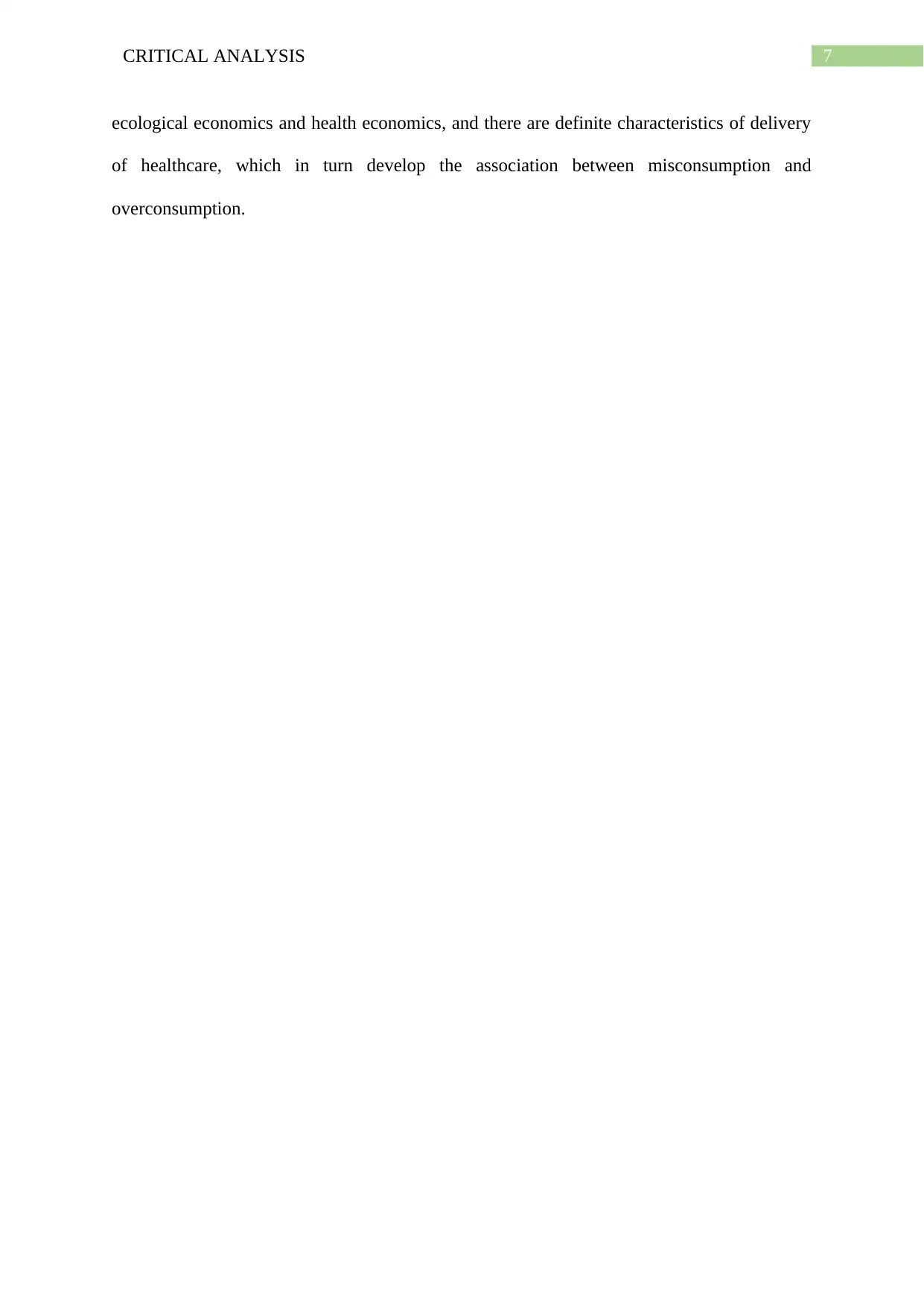
7CRITICAL ANALYSIS
ecological economics and health economics, and there are definite characteristics of delivery
of healthcare, which in turn develop the association between misconsumption and
overconsumption.
ecological economics and health economics, and there are definite characteristics of delivery
of healthcare, which in turn develop the association between misconsumption and
overconsumption.
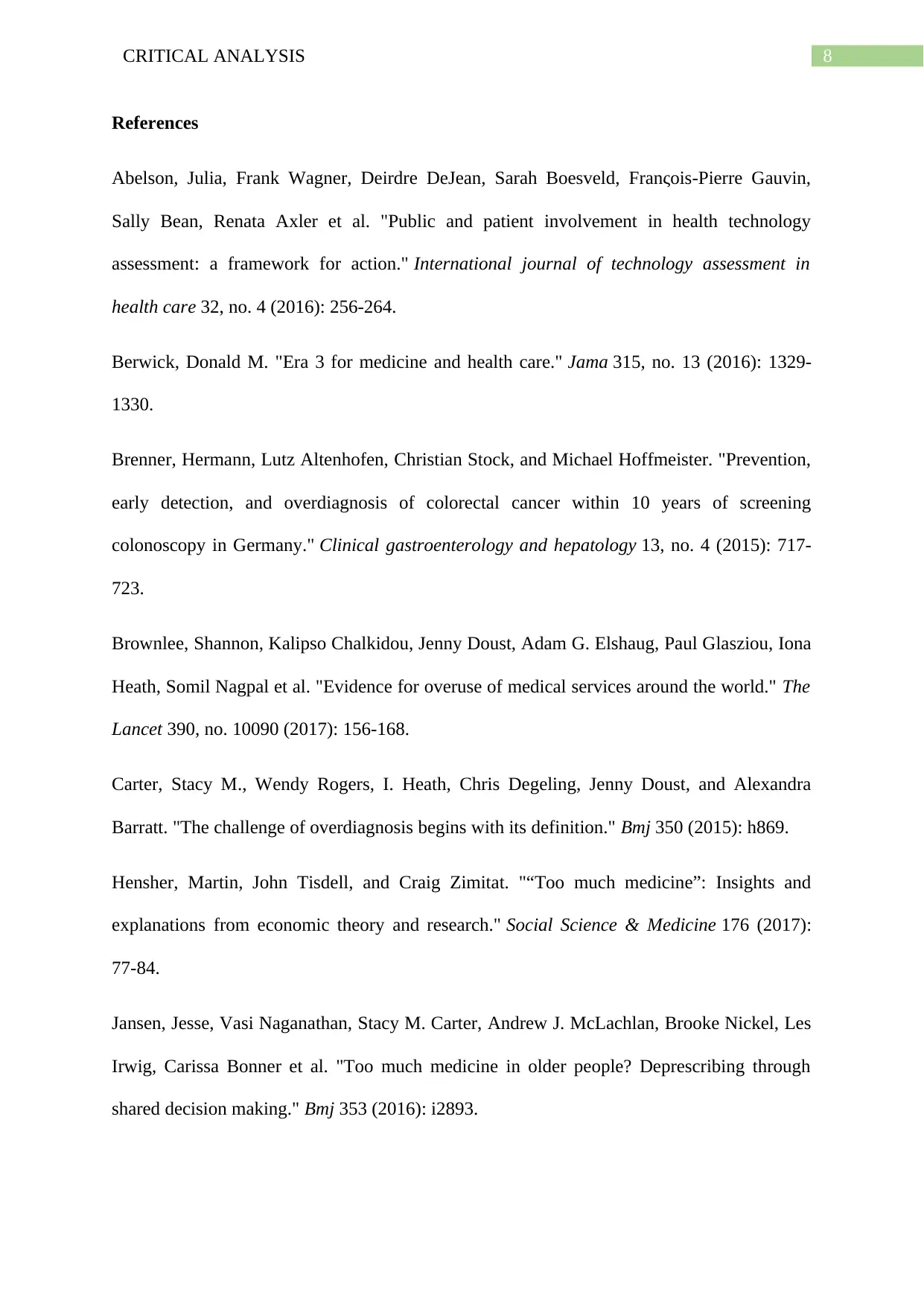
8CRITICAL ANALYSIS
References
Abelson, Julia, Frank Wagner, Deirdre DeJean, Sarah Boesveld, Franςois-Pierre Gauvin,
Sally Bean, Renata Axler et al. "Public and patient involvement in health technology
assessment: a framework for action." International journal of technology assessment in
health care 32, no. 4 (2016): 256-264.
Berwick, Donald M. "Era 3 for medicine and health care." Jama 315, no. 13 (2016): 1329-
1330.
Brenner, Hermann, Lutz Altenhofen, Christian Stock, and Michael Hoffmeister. "Prevention,
early detection, and overdiagnosis of colorectal cancer within 10 years of screening
colonoscopy in Germany." Clinical gastroenterology and hepatology 13, no. 4 (2015): 717-
723.
Brownlee, Shannon, Kalipso Chalkidou, Jenny Doust, Adam G. Elshaug, Paul Glasziou, Iona
Heath, Somil Nagpal et al. "Evidence for overuse of medical services around the world." The
Lancet 390, no. 10090 (2017): 156-168.
Carter, Stacy M., Wendy Rogers, I. Heath, Chris Degeling, Jenny Doust, and Alexandra
Barratt. "The challenge of overdiagnosis begins with its definition." Bmj 350 (2015): h869.
Hensher, Martin, John Tisdell, and Craig Zimitat. "“Too much medicine”: Insights and
explanations from economic theory and research." Social Science & Medicine 176 (2017):
77-84.
Jansen, Jesse, Vasi Naganathan, Stacy M. Carter, Andrew J. McLachlan, Brooke Nickel, Les
Irwig, Carissa Bonner et al. "Too much medicine in older people? Deprescribing through
shared decision making." Bmj 353 (2016): i2893.
References
Abelson, Julia, Frank Wagner, Deirdre DeJean, Sarah Boesveld, Franςois-Pierre Gauvin,
Sally Bean, Renata Axler et al. "Public and patient involvement in health technology
assessment: a framework for action." International journal of technology assessment in
health care 32, no. 4 (2016): 256-264.
Berwick, Donald M. "Era 3 for medicine and health care." Jama 315, no. 13 (2016): 1329-
1330.
Brenner, Hermann, Lutz Altenhofen, Christian Stock, and Michael Hoffmeister. "Prevention,
early detection, and overdiagnosis of colorectal cancer within 10 years of screening
colonoscopy in Germany." Clinical gastroenterology and hepatology 13, no. 4 (2015): 717-
723.
Brownlee, Shannon, Kalipso Chalkidou, Jenny Doust, Adam G. Elshaug, Paul Glasziou, Iona
Heath, Somil Nagpal et al. "Evidence for overuse of medical services around the world." The
Lancet 390, no. 10090 (2017): 156-168.
Carter, Stacy M., Wendy Rogers, I. Heath, Chris Degeling, Jenny Doust, and Alexandra
Barratt. "The challenge of overdiagnosis begins with its definition." Bmj 350 (2015): h869.
Hensher, Martin, John Tisdell, and Craig Zimitat. "“Too much medicine”: Insights and
explanations from economic theory and research." Social Science & Medicine 176 (2017):
77-84.
Jansen, Jesse, Vasi Naganathan, Stacy M. Carter, Andrew J. McLachlan, Brooke Nickel, Les
Irwig, Carissa Bonner et al. "Too much medicine in older people? Deprescribing through
shared decision making." Bmj 353 (2016): i2893.
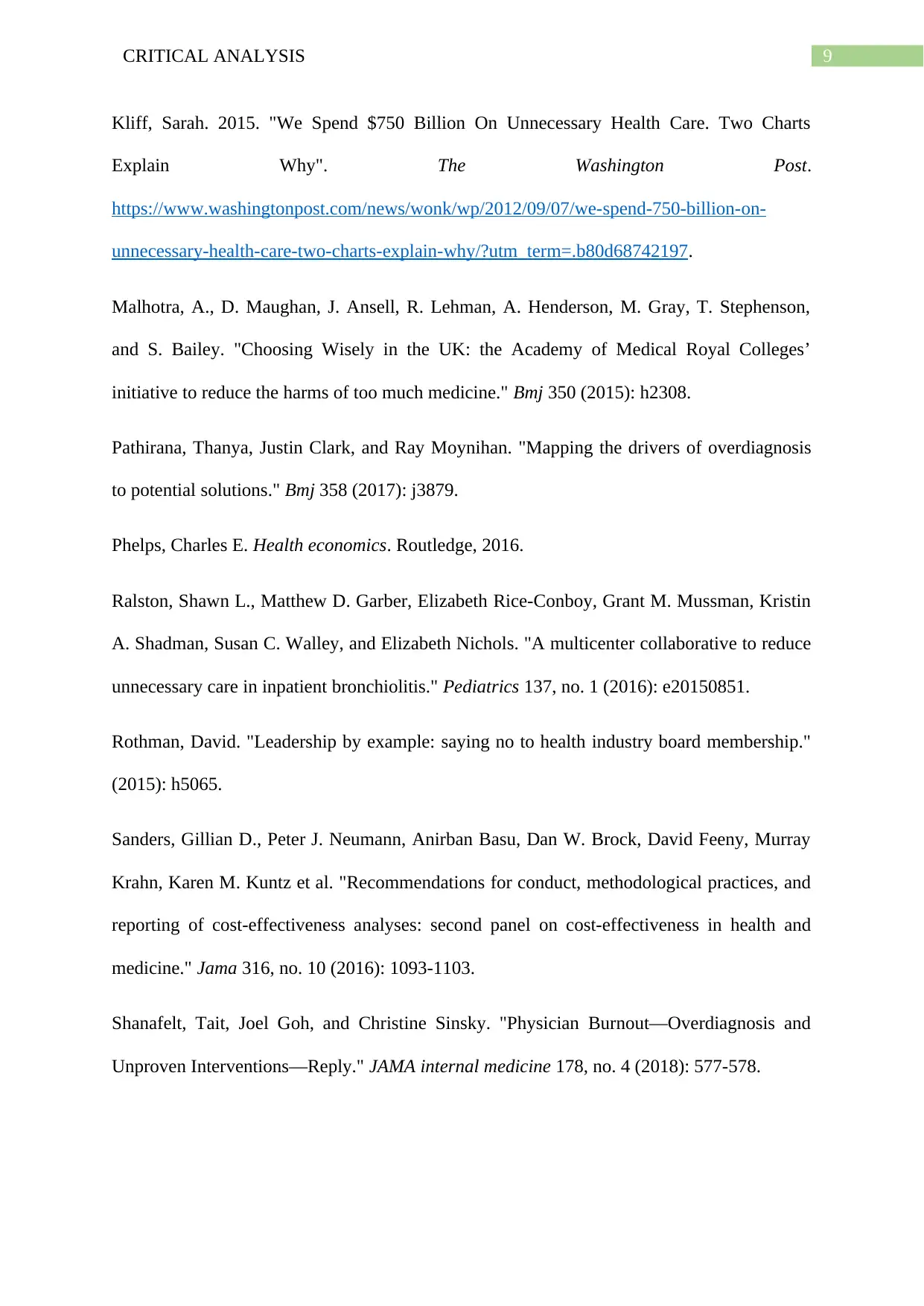
9CRITICAL ANALYSIS
Kliff, Sarah. 2015. "We Spend $750 Billion On Unnecessary Health Care. Two Charts
Explain Why". The Washington Post.
https://www.washingtonpost.com/news/wonk/wp/2012/09/07/we-spend-750-billion-on-
unnecessary-health-care-two-charts-explain-why/?utm_term=.b80d68742197.
Malhotra, A., D. Maughan, J. Ansell, R. Lehman, A. Henderson, M. Gray, T. Stephenson,
and S. Bailey. "Choosing Wisely in the UK: the Academy of Medical Royal Colleges’
initiative to reduce the harms of too much medicine." Bmj 350 (2015): h2308.
Pathirana, Thanya, Justin Clark, and Ray Moynihan. "Mapping the drivers of overdiagnosis
to potential solutions." Bmj 358 (2017): j3879.
Phelps, Charles E. Health economics. Routledge, 2016.
Ralston, Shawn L., Matthew D. Garber, Elizabeth Rice-Conboy, Grant M. Mussman, Kristin
A. Shadman, Susan C. Walley, and Elizabeth Nichols. "A multicenter collaborative to reduce
unnecessary care in inpatient bronchiolitis." Pediatrics 137, no. 1 (2016): e20150851.
Rothman, David. "Leadership by example: saying no to health industry board membership."
(2015): h5065.
Sanders, Gillian D., Peter J. Neumann, Anirban Basu, Dan W. Brock, David Feeny, Murray
Krahn, Karen M. Kuntz et al. "Recommendations for conduct, methodological practices, and
reporting of cost-effectiveness analyses: second panel on cost-effectiveness in health and
medicine." Jama 316, no. 10 (2016): 1093-1103.
Shanafelt, Tait, Joel Goh, and Christine Sinsky. "Physician Burnout—Overdiagnosis and
Unproven Interventions—Reply." JAMA internal medicine 178, no. 4 (2018): 577-578.
Kliff, Sarah. 2015. "We Spend $750 Billion On Unnecessary Health Care. Two Charts
Explain Why". The Washington Post.
https://www.washingtonpost.com/news/wonk/wp/2012/09/07/we-spend-750-billion-on-
unnecessary-health-care-two-charts-explain-why/?utm_term=.b80d68742197.
Malhotra, A., D. Maughan, J. Ansell, R. Lehman, A. Henderson, M. Gray, T. Stephenson,
and S. Bailey. "Choosing Wisely in the UK: the Academy of Medical Royal Colleges’
initiative to reduce the harms of too much medicine." Bmj 350 (2015): h2308.
Pathirana, Thanya, Justin Clark, and Ray Moynihan. "Mapping the drivers of overdiagnosis
to potential solutions." Bmj 358 (2017): j3879.
Phelps, Charles E. Health economics. Routledge, 2016.
Ralston, Shawn L., Matthew D. Garber, Elizabeth Rice-Conboy, Grant M. Mussman, Kristin
A. Shadman, Susan C. Walley, and Elizabeth Nichols. "A multicenter collaborative to reduce
unnecessary care in inpatient bronchiolitis." Pediatrics 137, no. 1 (2016): e20150851.
Rothman, David. "Leadership by example: saying no to health industry board membership."
(2015): h5065.
Sanders, Gillian D., Peter J. Neumann, Anirban Basu, Dan W. Brock, David Feeny, Murray
Krahn, Karen M. Kuntz et al. "Recommendations for conduct, methodological practices, and
reporting of cost-effectiveness analyses: second panel on cost-effectiveness in health and
medicine." Jama 316, no. 10 (2016): 1093-1103.
Shanafelt, Tait, Joel Goh, and Christine Sinsky. "Physician Burnout—Overdiagnosis and
Unproven Interventions—Reply." JAMA internal medicine 178, no. 4 (2018): 577-578.
Secure Best Marks with AI Grader
Need help grading? Try our AI Grader for instant feedback on your assignments.
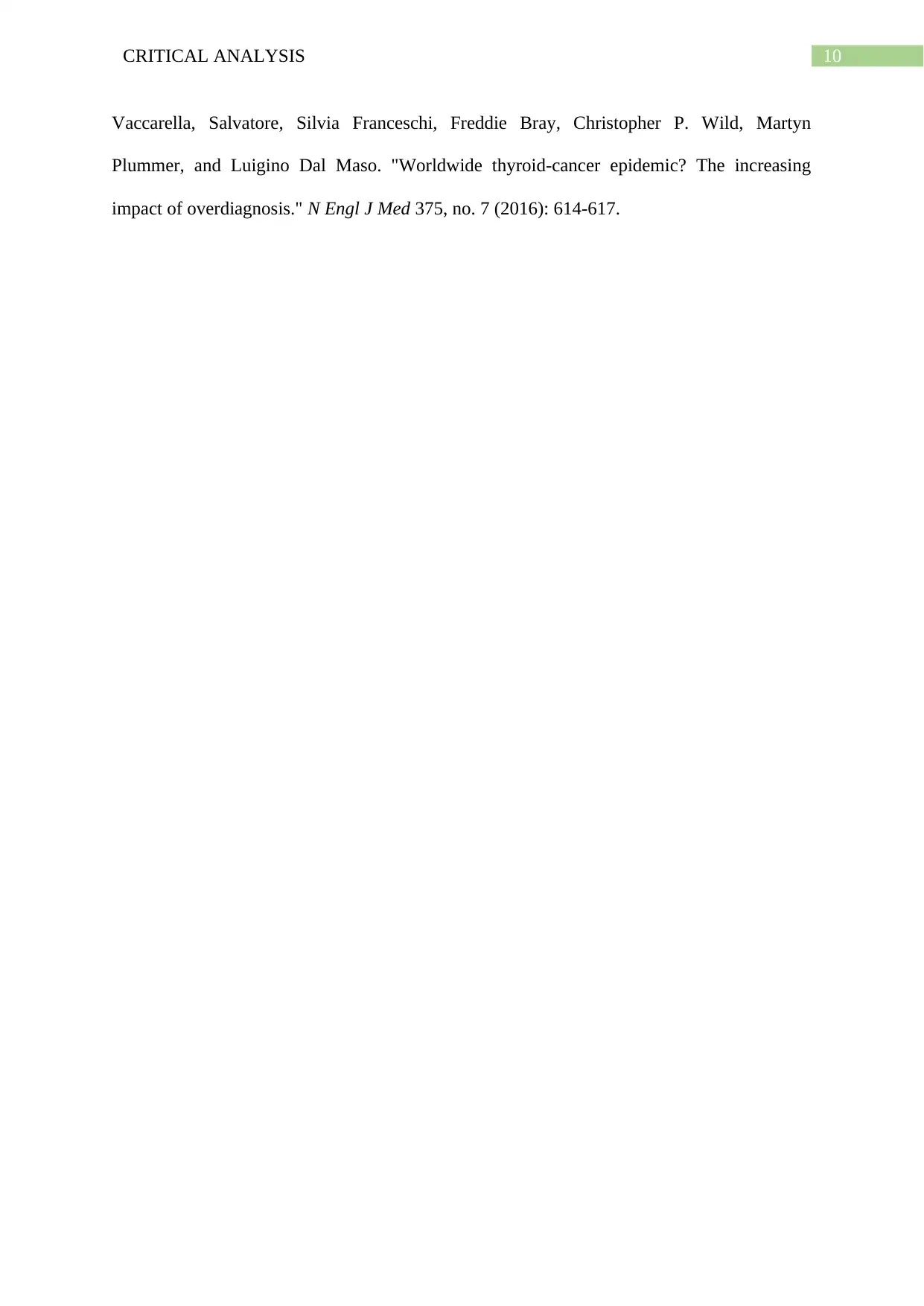
10CRITICAL ANALYSIS
Vaccarella, Salvatore, Silvia Franceschi, Freddie Bray, Christopher P. Wild, Martyn
Plummer, and Luigino Dal Maso. "Worldwide thyroid-cancer epidemic? The increasing
impact of overdiagnosis." N Engl J Med 375, no. 7 (2016): 614-617.
Vaccarella, Salvatore, Silvia Franceschi, Freddie Bray, Christopher P. Wild, Martyn
Plummer, and Luigino Dal Maso. "Worldwide thyroid-cancer epidemic? The increasing
impact of overdiagnosis." N Engl J Med 375, no. 7 (2016): 614-617.
1 out of 11
Related Documents
Your All-in-One AI-Powered Toolkit for Academic Success.
+13062052269
info@desklib.com
Available 24*7 on WhatsApp / Email
![[object Object]](/_next/static/media/star-bottom.7253800d.svg)
Unlock your academic potential
© 2024 | Zucol Services PVT LTD | All rights reserved.





